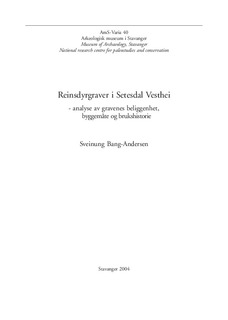| dc.description.abstract | The purpose is to analyse approximately 60 reindeer pitfall traps, which during the last 25 years have been identified
and partly archaeologically investigated in the Setesdal Vesthei, furthest south in range of mountains between
West and East Norway. Special weight will be attached to identifying the location of the traps as well as establishing
their construction and usage history. The pitfall traps are located in the high-mountain areas from 785 to 1325 m
a.s.l., the majority within an area of approximately 400 sq. km between the heads of the fjords in inner Ryfylke and
Bykle in upper Setesdal.
All pitfall traps are of the rectangular, stone-built South-Norwegian ”high-mountain type”. Half of them are
located less than 10 m from the water’s edge, and the traps characteristically exploit topographical bottlenecks, such
as the foot of steep mountain sides or the floor of narrow gorges. The pitfall traps are usually found singly, more
rarely several together and never as part of larger systems. The physical elements of the pitfall traps are then discussed,
defined and classified. Only seven traps (15%) lack any form of built approach construction. A clear
majority has a rectangular fall opening, a chamber tapering towards the bottom of the longitudinal and cross
sections, and are sunk about 75% into the ground. Prior to starting the building of the stone lining of the chamber,
it has been necessary to remove, on average, 5 cubic metres of gravel. The purpose of the pitfall traps has not been
to kill, but to passively catch and hold the prey alive and unhurt for hours or days until it could be killed and
dressed.
Nine pitfall traps have been archaeologically excavated during the period 1976-1979, and of these six have been
C-14 dated. The dates indicated that five of the traps are between 1800 and 600 years old (from the Early Iron Age
to the Early Middle Ages), and that one grave possibly dates back to the Bronze Age. The use of the pitfall traps is
seen as a secondary income source for the agricultural settlements of the nearest neighbouring valleys and fjord
heads. The distance between farm and pitfall trap varies from 6 to 25 kms and the altitude difference from 185 to
1125 m. Access to the traps has clearly been more difficult from the northern and western side (Suldal and Ryfylke)
than from the eastern and southern side (Setesdal and Sirdal). The modest number of known localities indicates
that pitfall hunting of reindeer generally has been of much less importance in Setesdal Vesthei than for instance on
the Hardangervidda plateau and in Rondane where pitfall traps are found in their thousands. These, however, have
so far been minimally archaeologically excavated and analysed. | no_NO |
